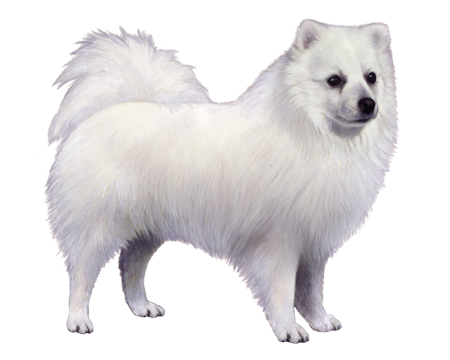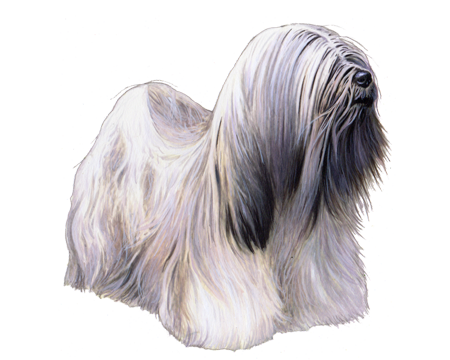
Schipperke
The Schipperke is a small, powerful breed. These curious little explorers have tenacious personalities and make excellent pets for active families.
Interested in discovering if your dog is a Schipperke?
Check out Wisdom Panel's DNA tests.

Schipperke Traits
General Appearance
These active, agile watchdogs have small, thickset bodies, and black fur. Schipperkes have mischievous, alert expressions and move with graceful trots.
Coat and Coloring
Schipperkes have distinct, black coats with several different lengths of hair. On the face, ears, front of the forelegs, and the hocks, the hair is short. But it is medium-length on the body. And on the ruff, cape, culottes, and jabot (the center of the chest, extending down between the front legs), it's long.
The Schipperke's hair growth pattern is also specific. Down the middle of the breed's back—starting behind the cape and continuing over the rump—the hair lies flat.
Schipperkes are double-coated. Their undercoats are short, soft, and denser around the ruff. This causes the straight, abundant topcoat—which is slightly harsh to the touch—to stand out. The Schipperke's coat should not be silky.
Distinctive Physical Traits
Schipperkes are square-bodied with broad, deep chests, well-sprung ribs, and short, muscular loins. Their fox-like faces have small, oval, dark brown eyes, small, triangular, erect ears, and little, black noses.
Schipperke Temperament
Schipperkes are inquisitive and love exploring. Though outgoing and affectionate with their people (including children), these dogs can be reserved with strangers.
Confident, attentive personalities—along with a tendency to bark at the first sign of trouble—make Schipperkes excellent watchdogs. But for the same reason, they may not be the best choice for apartment-dwelling pet parents.
Schipperkes thrive among active families that invite them to tag along for outdoor activities. With a strong prey drive, this breed might chase birds, rodents, and other small animals. So, you should only let your Schipperke off-leash in securely fenced areas.


Schipperke History
Bred in Belgium in the 1600s, the Schipperke (often pronounced "SKIP-er-kee") descended from a black sheepdog known as Leauvenaar. Back in the day, Schipperkes often worked aboard barges. Their jobs included catching vermin, nipping at the heels of tow horses, and serving as watchdogs. The Schipperke appears to be among the few breeds that do not suffer from seasickness. As a result, it remains a popular sailing companion.
First called Spitzke, this breed earned a new name in 1888 to honor its seafaring ways—Schipperke means "little captain." Schipperkes first appeared in a dog show in 1880, and their adorable features and outgoing personalities made them an instant hit. Soon, Belgium was exporting the dogs to breeders throughout the world.
Schipperke Care
Nutrition
Schipperkes need a high-quality dog food appropriate for their life stage (e.g., puppy, adult, senior). Consider a diet formulated for small, active breeds. To prevent weight-related health issues, measure out your dog's meals, and limit treats to no more than 10% of their daily calories.
Grooming
Schipperkes have minimal grooming needs—bathing and brushing every so often is usually adequate. That said, their double coats will need extra attention during spring and fall. Daily brushing during these times can help remove cast-off undercoats, helping your Schipperke look their best.
Trimming nails, cleaning ears, and brushing teeth should also be part of every dog's grooming routine, regardless of breed.
Exercise
Schipperkes are an active breed that requires a lot of exercise. Fortunately, regular walks or play sessions in the backyard will quickly tire out these small dogs. Schipperkes also seem to enjoy canine sport—such as rally, agility, flyball, and competitive obedience.
Don't let your Schipperke off-leash unless there is a secure fence. Otherwise, the little explorer may wander off and ignore commands to come back.
Training
The Schipperke's active and independent nature may cause this breed to follow its instincts instead of responding to commands. So, training can be a challenge, and patience and persistence are key. With regular reinforcement, your pup will pick up basic commands, new tricks, and establish positive habits—such as reduced barking.
Training also provides much-needed physical and mental stimulation. Fast-paced games and puzzles appeal to this intelligent breed. So, keep your Schipperke engaged with high-speed, interesting activities. Positive, rewards-based training—offering treats, toys, and praise instead of harsh criticism—also works well. Finally, don't forget socialization, which will help your Schipperke feel confident around unfamiliar people, pets, and situations.

Schipperke Genetic Health Conditions
-
Mucopolysaccharidosis Type IIIB (Discovered in the Schipperke)
Mucopolysaccharidosis Type IIIB (MPS IIIB) is a disease of progressive incoordination, first in the hindlimbs and later progressing to all four legs. Leg movements become erratic when walking and affected dogs have difficulty balancing.
Knowing if your Schipperke is a carrier or at-risk for these conditions can help you and your veterinarian plan for your pup’s lifelong care. With Wisdom Panel™ Premium, you can get results for over 200 genetic health tests.
Breed Group
Companion
This group consists of dogs typically bred for the specific purpose of human companionship, and many are popular pets because of their gentle nature. They became more common as the concept and luxury of dogs as pets prevailed.
Resources
https://www.akc.org/dog-breeds/schipperke/
https://www.akc.org/expert-advice/lifestyle/what-was-the-schipperke-bred-to-do/
http://images.akc.org/pdf/breeds/standards/Schipperke.pdf
Reviewed July 26, 2020 by Cindy Elston, DVM, MPH



























_Color.png)





















